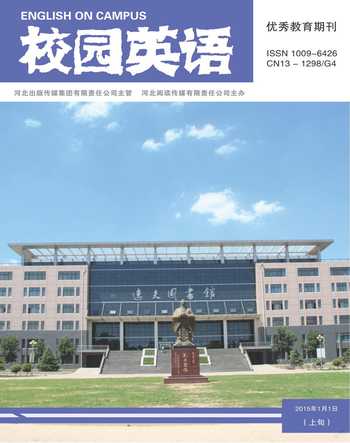A study of the Ways the Speaker Choose According to the Audiences’Status
2015-05-30王莉娜
王莉娜
【Abstract】Language has different functions: “Informative Function, Interpersonal Function, Performative Function, Emotive Function, Phatic Communion Function, Recreational Function, and Metalingual Fuction”.According to different nationality of the audience, the speaker should use different language “code” to represent the special word or even simple word that make the audience accept the information efficiently.
【Keywords】function, status of speakers
Language has different functions: “Informative Function, Interpersonal Function, Performative Function, Emotive Function, Phatic Communion Function, Recreational Function, and Metalingual Fuction”[1].“The audience design framework distinguishes between several kinds of audience types based on three criteria from the perspective of the speaker: known (whether an addressee is known to be part of a speech context), ratified (the speaker acknowledges the listeners presence in the speech context), or addressed (the listener is directly spoken to).”[2]
When will you do the spray pattern?---- Professional
When will you spray the board? ---- Unprofessional
Example a is the speaker asking the mechanic workers, if he is professional and experienced, he should know what is “spray pattern”, that is the process to check the quality of the painting.
To the “professional” audience, its the reflection of the language Informative Function, “language serves an informative function when it is used to express the speakers opinion, to state a face, or to reason things out.”[1]and Performative Function to perform action.To the “unprofessional” audience is just Interpersonal function, “serves to establish and maintain social relations between people.”[2]
I.The language “Code”(Invention or borrowing)
According to different nationality of the audience, the speaker should use different language “code” to represent the special word or even simple word that make the audience accept the information efficiently.
a.We will paint the electrophoresis car body.
We will paint the ED.
b.We will check the automatic signal on the car with tapes.
We will use the “zebra” to “ghost”.
Example a shows that if the audience are from Germany or Chinese and they work in spray shop, they know what ED is, its a borrowed word from German and it is an acronym.That achieves the Informative Function of language.To English listeners, the speaker can choose either one to communicate.Example b shows that the language code“zebra”and “ghost” make communication in an efficient way, that is meaning shift in Semantic change, and the speaker prefer to use the language code toward any audience.
II.The ways the speaker choose according to audiences educational background.
According to audiences educational background, the speaker will choose different ways to communicate or discuss, and the speakers aims of communication are different too.
Eg.Do not touch the light barrier!
The speakers aim is not only communicate but also want to make sure in the future nothing dangerous will happen.Thats the Performative Function of language.If the audience knows well of the usage of the light barrier, the speaker will not say any additional thing and the body language are useless.The aim of the speaker is only communicate, thats the Informative Function of language.
III.Conclusion
Speakers have to recognize the status of different people in order to achieve the function of language and his aim, that can make the process of communication without any misunderstood or confusion.
References:
[1]Hu.Zhuanglin.An Introduction to Linguistics, Peking University press, 2001.
[2]Bell, A.(2001) Back in style: Reworking audience design.Cambridge: Cambridge University Press.
[3]SeyedFoadEbrahimi,Seyed Jamal Ebrahimi.Markedness in Writing: A Case of EFL Students[J].Theory and Practice in Language Studies,2012,24.
[4]HodaSarkhoush.Relationship among Iranian EFL Learners Self-efficacy in Writing, Attitude towards Writing, Writing Apprehension and Writing Performance[J].Journal of Language Teaching and Research,2013,45.
